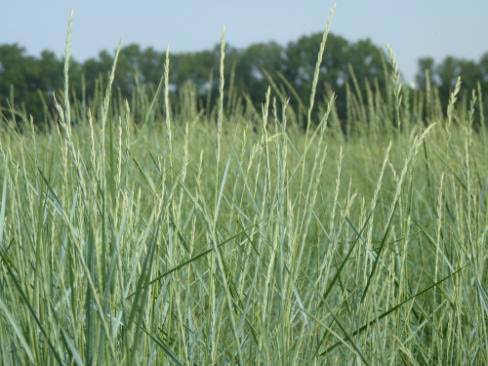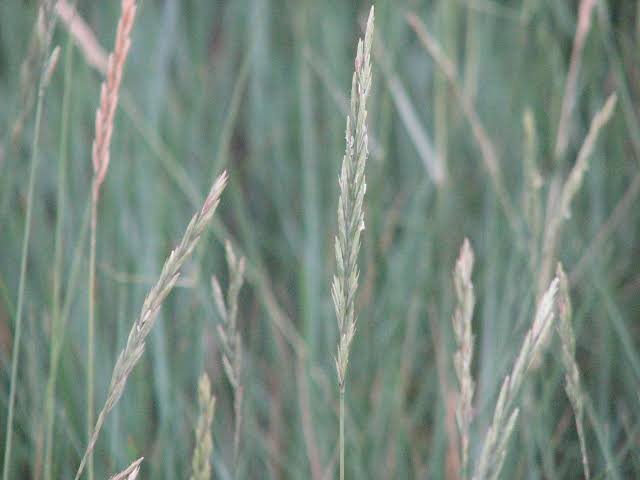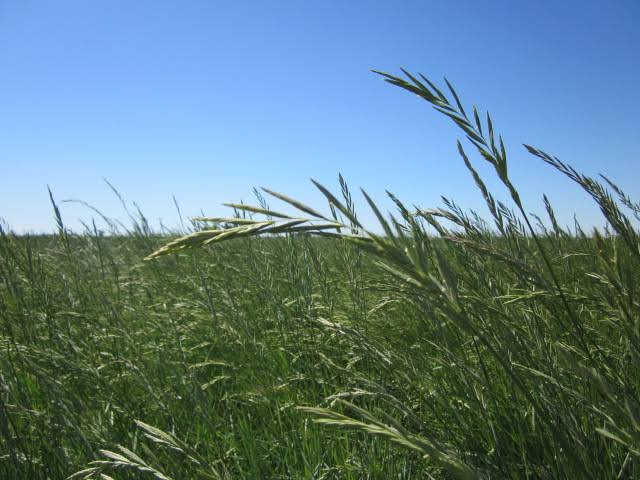Western wheatgrass (Pascopyrum smithii) is a kind of grass that grows in the western regions of North America. This grass is important because it provides various benefits to the environment and animals.
Firstly, Western wheatgrass is known for its ability to prevent soil erosion. Its roots spread widely and hold the soil together, making it less likely for the soil to be washed away by wind or water. This is crucial in maintaining the health of the land and preventing degradation.
Moreover, Western wheatgrass plays a significant role in providing food for grazing animals. Animals like deer, elk, and various species of grasshoppers feed on this grass. Its nutritious leaves and stems serve as a vital part of the diet for these animals, contributing to their overall well-being.
In addition to supporting wildlife, Western wheatgrass is also beneficial for livestock. Many ranchers value this grass for its nutritional content, using it as forage for cattle and sheep. The grass’s resilience in different climates makes it a reliable source of sustenance for animals, especially in arid and semi-arid regions.
Furthermore, Western wheatgrass is known to be drought-tolerant. This means it can survive in areas with limited water availability, making it a resilient and adaptable plant. Its ability to thrive in challenging conditions makes it a valuable component in maintaining the ecological balance of diverse ecosystems.
Beyond its ecological importance, Western wheatgrass has been used in land reclamation projects. When areas have been disturbed by human activities such as mining or construction, planting Western wheatgrass helps restore the soil structure and support the reestablishment of native vegetation.
In addition, Western wheatgrass, scientifically known as Pascopyrum smithii, is a vital component of the ecosystems in the western regions of North America. Its role in preventing soil erosion, providing food for wildlife and livestock, and its adaptability to challenging environments make it a key player in maintaining ecological balance and supporting various forms of life.
Read Also: Timber Wolf: Health and Lifespan
How To Grow Western Wheatgrass (Pascopyrum smithii)

Growing Western wheatgrass (Pascopyrum smithii) can be a rewarding endeavor, especially if you are looking to enhance your landscape, support wildlife, or contribute to sustainable forage for livestock. Here’s a simple guide on how to grow Western wheatgrass:
1. Choose the Right Location: Select a site with well-drained soil and receive plenty of sunlight. Western wheatgrass is adaptable, but it thrives in areas with good sunlight exposure.
2. Soil Preparation: Prepare the soil by removing any weeds or debris. Loosen the soil to a depth of about 4-6 inches to facilitate root growth. Western wheatgrass can tolerate a range of soil types but prefers well-drained soils.
3. Seed Selection: Obtain high-quality Western wheatgrass seeds from a reputable source. Ensure the seeds are fresh and have been stored properly to maintain viability.
4. Planting Time: Plant the seeds in the early spring or fall. These seasons provide optimal conditions for germination and establishment. Broadcasting the seeds evenly over the prepared soil is a common method.
5. Seed Depth: Plant the seeds at a depth of about 1/4 to 1/2 inch. Avoid planting them too deep, as this may hinder germination.
6. Watering: Keep the soil consistently moist until the seeds germinate and the seedlings establish. Once established, Western wheatgrass is somewhat drought-tolerant but benefits from occasional watering during dry periods.
7. Maintenance: Monitor for weed competition, especially during the initial stages of growth. Consider applying a light layer of mulch to help retain soil moisture and suppress weeds.
8. Growth and Establishment: Be patient, as Western wheatgrass may take some time to establish fully. Once established, it will send out rhizomes and form dense tufts of grass.
9. Grazing and Harvesting: If you are growing Western wheatgrass for livestock forage, plan grazing or harvesting carefully to allow the grass to recover between uses. Avoid overgrazing, as this can stress the plants.
10. Naturalization: Western wheatgrass has the potential to naturalize in the right conditions. Allow some areas to go to seed, and the grass may spread naturally.
By following these simple steps, you can contribute to the growth and success of Western wheatgrass, supporting its role in maintaining healthy ecosystems and providing valuable forage for wildlife and livestock.
How To Care For Western Wheatgrass (Pascopyrum smithii)
Caring for Western wheatgrass (Pascopyrum smithii) involves a combination of proper maintenance practices to ensure its health and longevity. Here are some essential care tips:
1. Watering: While Western wheatgrass is somewhat drought-tolerant once established, regular watering is crucial during the initial stages of growth. Ensure the soil remains consistently moist until the plants establish their root systems.
2. Soil Quality: Maintain well-drained soil conditions. Avoid waterlogged or compacted soil, as this can hinder root development. Periodically check the soil quality and amend it if necessary with organic matter.
3. Weed Control: Monitor the area for weed growth, especially during the early stages of Western wheatgrass growth. Weeds can compete for nutrients and sunlight, so promptly remove any unwanted vegetation.
4. Fertilization: Western wheatgrass generally doesn’t require heavy fertilization. However, if the soil lacks essential nutrients, consider applying a balanced, slow-release fertilizer according to the specific needs of the grass.
5. Grazing Management: If Western wheatgrass is part of a grazing system, practice sustainable grazing management. Avoid overgrazing, which can stress the plants and reduce their resilience. Implement rotational grazing to allow for recovery periods.
6. Pruning and Thinning: Periodically assess the density of the Western wheatgrass stand. If the grass becomes overly dense, consider thinning it out to allow for better air circulation and sunlight penetration. This can promote healthier growth.
7. Disease and Pest Management: Keep an eye out for signs of diseases or pests. While Western wheatgrass is relatively resistant, occasional pest issues or diseases may arise. Address these promptly using appropriate methods, such as natural predators or targeted treatments.
8. Mulching: Applying a light layer of mulch around the base of Western wheatgrass can help retain soil moisture, suppress weeds, and regulate soil temperature. Use organic mulch materials like straw or wood chips.
9. Monitoring: Regularly monitor the overall health and appearance of Western wheatgrass. Look for any signs of stress, discoloration, or other abnormalities. Early detection of issues allows for timely intervention.
10. Natural Processes: Allow some areas of the Western wheatgrass to go to seed naturally. This can contribute to the grass’s self-sustaining growth and ensure its long-term presence in the landscape.
By incorporating these care practices, you can help Western wheatgrass thrive, whether it’s part of a natural landscape, a forage system for livestock, or an element of a reclamation project. Regular attention to its needs will contribute to the health and resilience of this valuable grass species.
Read Also: The Appearance and Features of Coyotes
The Uses of Western Wheatgrass (Pascopyrum smithii)

Western wheatgrass (Pascopyrum smithii) serves various important purposes, contributing to both natural ecosystems and human activities. Here are some of its primary uses:
1. Wildlife Habitat: Western wheatgrass provides valuable habitat and food for a range of wildlife species. Animals such as deer, elk, and various grassland birds rely on this grass for forage and shelter, contributing to biodiversity in natural ecosystems.
2. Livestock Forage: One of the significant uses of Western wheatgrass is as forage for livestock. Cattle, sheep, and other grazers find the grass nutritious, making it a valuable component in the diets of these animals. Its drought tolerance adds to its appeal in regions with variable water availability.
3. Erosion Control: The extensive root system of Western wheatgrass helps prevent soil erosion. Planting this grass is a common practice in areas prone to erosion, especially after disturbances like wildfires or land development.
4. Land Reclamation: Western wheatgrass plays a role in land reclamation projects. When areas have been disturbed by human activities such as mining, the planting of Western wheatgrass aids in stabilizing the soil and restoring native vegetation.
5. Soil Improvement: The deep roots of Western wheatgrass enhance soil structure and fertility. This contributes to overall soil health and can be beneficial in areas where soil quality is a concern.
6. Conservation and Restoration: Conservation efforts often involve the use of Western wheatgrass to restore native grassland ecosystems. Its adaptability and ability to thrive in different environments make it a valuable tool in restoring and conserving natural landscapes.
7. Ornamental Landscaping: Due to its attractive tufted growth habit and fine-textured foliage, Western wheatgrass is sometimes used in ornamental landscaping. It adds aesthetic value to gardens and public spaces, especially in regions where native plants are preferred.
8. Biomass Production: Western wheatgrass can be utilized for biomass production. It has the potential to be a renewable resource for bioenergy, and research is ongoing to explore its use in sustainable energy production.
9. Traditional Uses by Indigenous Peoples: Some indigenous communities have historical and cultural uses for Western wheatgrass. While specifics can vary, the grass may have been used for traditional purposes, such as basket weaving or medicinal applications.
10. Soil Stabilization in Restoration Projects: In restoration efforts, especially in areas with disturbed soils, Western wheatgrass aids in stabilizing the soil. Its extensive root system helps control erosion, allowing for the establishment of other native plants.
These diverse uses highlight the ecological and practical significance of Western wheatgrass, showcasing its versatility in addressing various environmental and human needs.
Frequently Asked Questions (FAQs)
Q: What is Western wheatgrass (Pascopyrum smithii)?
A: Western wheatgrass, scientifically known as Pascopyrum smithii, is a grass species native to the western regions of North America. It is known for its role in preventing soil erosion, providing forage for wildlife and livestock, and contributing to ecosystem health.
Q: How do I grow Western wheatgrass?
A: Choose a sunny location with well-drained soil, plant seeds in early spring or fall, and water regularly until the grass establishes. Avoid overgrazing if used for livestock, and consider naturalization for long-term growth.
Q: Is Western wheatgrass drought-tolerant?
A: Yes, Western wheatgrass is somewhat drought-tolerant, making it well-suited for regions with limited water availability. However, consistent watering during the establishment phase is crucial.
Q: Can Western wheatgrass be used for livestock forage?
A: Absolutely. Western wheatgrass is a valuable forage for cattle and sheep. It provides nutritious leaves and stems, contributing to the diet of grazing animals.
Q: How does Western wheatgrass contribute to soil improvement?
A: The extensive root system of Western wheatgrass helps stabilize the soil, prevent erosion, and enhance soil structure. It is often used in land reclamation projects to restore soil health.
Q: Is Western wheatgrass suitable for ornamental landscaping?
A: Yes, Western wheatgrass is sometimes used in ornamental landscaping due to its attractive growth habit and fine-textured foliage. It adds aesthetic value to gardens and public spaces.
Q: Can Western wheatgrass be used in land reclamation projects?
A: Yes, Western wheatgrass is often employed in land reclamation to stabilize soil and restore native vegetation in areas impacted by human activities like mining or construction.
Q: What is the role of Western wheatgrass in wildlife habitat?
A: Western wheatgrass provides habitat and food for wildlife such as deer, elk, and grassland birds. Its presence contributes to biodiversity in natural ecosystems.
Q: Are there any traditional uses of Western wheatgrass by indigenous peoples?
A: Some indigenous communities may have historical and cultural uses for Western wheatgrass, which can vary, including applications like basket weaving or medicinal uses.
Q: Can Western wheatgrass be used for biomass production?
A: Yes, there is ongoing research exploring the potential use of Western wheatgrass for biomass production, making it a renewable resource for bioenergy.
Read Also: Activated Sludge System Process

